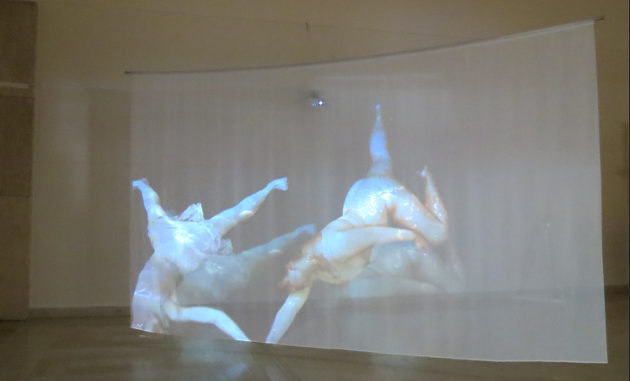
Some may argue that art is a purely subjective form of self-expression. But this logic fails to consider that the individual and the art they produce are inextricable from the places, people and landscapes that surround them. The Portland Art Museum recently unveiled an exhibit titled “the map is not the territory” which directly examines this relationship between the artist and the external world. The installation was created by a few artists who have been influenced by the Pacific Northwest as a physical location and seeks to discuss climate change, artistic and geographical representation and the effects of colonization on indigenous peoples.
The solemnity of this exhibit was immediately apparent upon walking through the entrance. Massive projector screens confront the viewer with intricate movements of two performance artists superimposed on videos of burning forests, nuclear holocausts and raining ash. Using motion-detecting cameras placed throughout the room, the ghostly forms of people walking around are captured and displayed on the screens among this chaos of dance and destruction. This portion of the installation was designed to raise important questions about the nature of climate change in relation to the experience of the individual. This room not only shocks the viewer but prepares them for the contemplation that comes with the rest of the exhibit.
A vertical, suspended pyramid of motionless rocks is the centerpiece of the next room. Entitled “Moving Mountains,” this piece was designed by the artist Annette Bellamy in response to her experiences working as a fisherwoman on the shores of Alaska. Like most of the other works, no caption accompanies this piece. Instead the viewer is challenged to assign their own meaning. Scattered throughout the room are sculptures, articles of clothing and installation pieces made of material native to the Pacific Northwest, which includes fish scales, bones and shells. Much of the art located in this room plays with the idea that objects themselves are able to tell a story without prior knowledge or information.
One of the most interesting portions of the exhibit is a series of portrait photographs that lines the entirety of the north wall. The subjects are members of a queer community of indigenous Alaskan peoples. The artist Jenny Irene Miller created the piece as a way to represent gender and sexual minorities of this native population. As a result of colonization, the voices of these marginalized people have been confined almost entirely to the background. Each portrait is intended to highlight the individuality of the person at hand and to invite the viewer to think about how gender and sexuality are expressed in isolated, rural communities.
Perhaps the power of this exhibit lies in the responsibility that it imposes on the individual viewer. Most of the art deals with themes of colonization, environmental decay and representation. But these heavy subjects are not merely discussed and then hastily forgotten. From the radiant projector screens to the sculptures modeled from fish parts, everything challenges the individual to ascribe their own meaning to different pieces. In other words, everything is implied, and nothing is directly told. This weight of interpretation on the viewer allows for a moment of personal introspection in response to the various questions the exhibit raised about identity, culture and landscape. It is impossible to leave this space without gaining at least some new knowledge about one’s self or place in the world. This knowledge may be difficult to articulate to others, but it is this subjective, almost ineffable insight that distinguishes this exhibit as an extraordinary space for reflection and subsequent action.
Subscribe to the Mossy Log Newsletter
Stay up to date with the goings-on at Lewis & Clark! Get the top stories or your favorite section delivered to your inbox whenever we release a new issue.

Leave a Reply